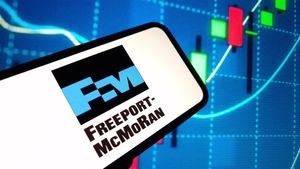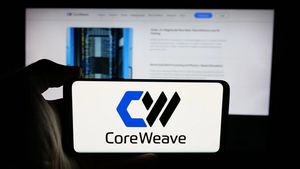
New data released today, September 26, 2025, reveals a robust surge in US consumer spending, acting as a crucial pillar of economic resilience. However, a deeper dive into the figures indicates that this growth is disproportionately driven by the nation's wealthiest households, raising questions about economic equity and the long-term stability of market-fueled consumption.
The U.S. Bureau of Economic Analysis (BEA) reported a significant 0.6% increase in Personal Consumption Expenditures (PCE) for August, following a 0.5% rise in July. This stronger-than-expected spending keeps the economy on solid footing as the third quarter concludes. While seemingly positive, this trend highlights a growing reliance on the spending power of high-income households, who now account for approximately half of all consumer spending, a substantial increase from previous decades. This "wealth effect," where rising stock market values and home prices encourage more spending, is propelling the economy forward, but also introduces a potential vulnerability if asset markets were to falter.
The Affluent Engine: A Detailed Look at the Spending Surge
The latest consumer spending report paints a vivid picture of economic activity, with US personal spending climbing to $21.112 trillion in August 2025. This 0.6% increase surpassed market forecasts and marked the third consecutive month of solid gains, with real personal spending (adjusted for inflation) also rising by 0.4%. The spending increase was broad-based, encompassing both goods and services.
Spending on goods saw a 0.7% jump, fueled by discretionary purchases like furnishings, clothing, and recreational items. Notably, price declines in certain categories such as recreational goods, vehicles, major appliances, and household supplies contributed to increased consumption, while other durable goods like jewelry, watches, and cell phones experienced price increases. Services outlays also advanced by 0.5%, driven by higher expenditures on transportation, hotels, restaurants, and recreational activities. Despite these gains, the Personal Saving Rate declined to 4.6% in August, its lowest level in 2025, suggesting that consumers are increasingly drawing on savings to maintain their spending habits.
This robust spending comes against a backdrop of consistent economic expansion throughout 2025, with real GDP growing by an upwardly revised 3.8% in the second quarter. However, the resilience is not uniform. Affluent consumers, defined as those earning over $250,000 annually and holding 70% of consumer wealth, are the primary drivers. They account for 56% of spending and benefit from a strong labor market, rising real wages, a booming stock market, and increasing home prices. Their financial stability allows them to continue spending freely, particularly in areas like travel and luxury goods, while lower-income households face greater economic pressures.
The immediate market reaction to the report was largely positive, with the Dow Jones Industrial Average (DJIA) and S&P 500 (SPX) both rising, bringing stocks near all-time highs. However, the strong economic data also led investors to pare back expectations for Federal Reserve rate cuts, pushing Treasury yields higher. The US dollar strengthened against major currencies like the euro and yen, as the economy's resilience complicated the Fed's monetary policy outlook. This scenario suggests that while the economy is strong, the path to lower interest rates may be longer than anticipated.
Corporate Winners and Losers in a Bifurcated Market
The current landscape of affluent-driven consumer spending creates a clear bifurcation in the market, with distinct winners and potential losers among public companies. Businesses catering to the high-income demographic are set to thrive, while those reliant on broader, less affluent consumer bases may face headwinds.
Companies Set to Win:
- Luxury Goods Retailers and Brands: Firms specializing in high-end apparel, accessories, and exclusive goods are direct beneficiaries. Affluent consumers are willing to pay a premium for quality and prestige. Examples include LVMH Moët Hennessy Louis Vuitton (EPA: LVMH), Hermès International (EPA: RMS), and Ferrari (NYSE: RACE), all of whom benefit from strong pricing power and demand for personalized, exclusive items. Luxury department stores like Dillard's (NYSE: DDS) and premium accessory makers like Tapestry (NYSE: TPR), owner of Coach and Kate Spade, are also well-positioned. Even luxury home furnishings retailers like RH (Restoration Hardware) (NYSE: RH) see performance correlated with affluent-favored stock and real estate markets.
- High-End Travel and Hospitality: Wealthy individuals continue to prioritize experiences. Luxury hotel chains such as Marriott International (NASDAQ: MAR) and Hilton Worldwide Holdings (NYSE: HLT) (through brands like Ritz-Carlton, St. Regis, Waldorf Astoria) will see increased occupancy and higher average daily rates. Major airlines like Delta Air Lines (NYSE: DAL) and United Airlines (NASDAQ: UAL) benefit from booming premium ticket sales (business and first-class) and international travel.
- Premium and "Upleveled" Retailers: Even mass-market retailers can benefit by strategically targeting higher earners. Walmart (NYSE: WMT), for instance, has gained market share from higher-income households by offering premium brands like Apple and Bose. Amazon (NASDAQ: AMZN) also benefits broadly from increased online retail volumes, including high-value purchases.
- Financial Services (Premium Offerings): Companies like American Express (NYSE: AXP) and JPMorgan Chase (NYSE: JPM), with their significant high-income client bases, report increased spending, particularly in premium categories like dining and airfare, leading to higher transaction volumes and interest income.
Companies Facing Challenges (or Limited Gains):
- Mid-Tier and Value-Oriented Retailers: Businesses primarily serving lower and middle-income demographics, such as Dollar General (NYSE: DG), may struggle as these consumers' discretionary income is squeezed by inflation and rising costs of essentials. Mid-priced apparel chains also face headwinds as consumers gravitate towards either luxury or deep-discount options.
- Certain Luxury Brands with "Aspirational" Shopper Dependence: While luxury generally thrives, some brands like Burberry (LON: BRBY) or specific segments within Kering (EPA: KER) (owner of Gucci) have recently reported struggles. This is attributed to shifting affluent consumer values (e.g., sustainability, experiences over goods) and a potential pullback from "aspirational" buyers more sensitive to economic shifts.
- General "Essentials" Providers (without premium segments): While always necessary, companies focused solely on basic essentials may not see significant growth from this affluent spending surge. For example, Costco Wholesale Corporation (NASDAQ: COST), despite its strong business model, might see its stock valuation challenged if the primary spending driver is high-margin discretionary items elsewhere.
The Wider Significance: Inequality, Policy, and Historical Echoes
The sustained rise in US consumer spending, predominantly fueled by affluent households, is not merely a fleeting economic data point; it signifies a deeper, evolving economic structure with profound implications for inequality, policy, and societal stability. This pattern reinforces the notion of a "K-shaped" economic recovery, where different segments of the economy experience sharply divergent outcomes.
This trend fits squarely into broader industry trends that have been emerging since the pandemic. The luxury market, while resilient, is becoming increasingly reliant on a narrower customer base, with a noticeable shift from luxury goods towards high-end services like travel and bespoke experiences. This creates a bifurcated retail landscape where luxury and off-price segments thrive, leaving mid-tier retailers struggling. The "experience economy" is flourishing, as affluent consumers prioritize unique, curated moments over material possessions. These ripple effects mean that companies not adapting to these shifts—either by "upleveling" their offerings or by strategically targeting value—risk being left behind. Furthermore, an economy disproportionately fueled by the wealthy could lead to job creation concentrated in sectors serving these consumers, potentially exacerbating labor market inequalities.
From a regulatory and policy standpoint, this economic reliance on affluent spending intensifies concerns about economic inequality. While headline GDP figures may appear robust, they can mask underlying financial fragility for a majority of the population. This complicates the Federal Reserve's ability to accurately gauge economic health and set appropriate monetary policy, as traditional consumer sentiment surveys might not reflect the true spending power distribution. Such a scenario is likely to intensify calls for policies aimed at reducing the wealth gap, including more progressive taxation, expanded social safety nets, and investments in education. Moreover, an economy heavily dependent on volatile asset markets (stocks, real estate) for affluent wealth creation becomes inherently more vulnerable to asset price corrections, which could trigger a sharp contraction in spending and broader economic instability.
Historically, periods of significant economic inequality, such as the Gilded Age or the 1920s, also saw a disproportionate influence of the wealthy on consumer markets. However, the current "K-shaped" recovery, where different income groups experience sharply divergent economic paths, is a more recent and distinct phenomenon post-pandemic. The long-term trend of rising income inequality in the US since the 1980s provides a crucial context, with the current level of spending dependence on the top 10% being a record in data going back to 1989. This historical perspective suggests that a sustained reliance on affluent spending alone may not be sufficient for robust, equitable, and stable long-term economic expansion, potentially leading to concerns about "secular stagnation."
What Comes Next: Navigating a Bifurcated Future
The trajectory of US consumer spending, particularly its reliance on affluent households, sets the stage for a complex economic future. Both short-term adjustments and long-term strategic pivots will be necessary for businesses and policymakers alike.
In the short-term (late 2025 - 2026), the luxury market is expected to maintain its resilient performance, driven by high-income shoppers. This will likely deepen the "horseshoe effect" in retail, benefiting both luxury and off-price segments while squeezing traditional mid-range stores. Experiential spending will continue to see a boost, as affluent consumers prioritize unique travel and exclusive events. However, overall real consumer spending growth is projected to moderate, slowing from earlier in 2025 into 2026 due to factors like a cooling labor market, tariff-induced inflation, and policy uncertainties. The "wealth effect" will continue to support affluent spending, but its impact on overall growth may lessen if asset price appreciation slows.
Looking further into the long-term (2027 and beyond), demographic shifts will play a crucial role. Gen Z, projected to be the wealthiest generation in history, is set to significantly influence markets, bringing new digital habits and a willingness to pay for convenience. The growing number of mass-affluent individuals transitioning to high-net-worth status will also reshape consumer demand. However, the rising economic inequality, exacerbated by affluent-driven spending, poses a long-term challenge, potentially leading to social tensions and impacting overall economic dynamism. Digitalization and AI will become even more critical, with companies leveraging these technologies for hyper-personalization and enhanced customer experiences. A focus on health, wellness, and sustainability is also expected to grow within the affluent segment.
Strategic pivots for businesses will involve hyper-personalization, data-driven marketing, and a relentless focus on customer experience, leveraging AI for efficiency while maintaining a human touch. Agile inventory and supply chain management will be crucial for luxury and specialty goods. Brands must also emphasize value and longevity in their premium offerings and adapt to a local-to-global balance in their strategies. For financial services, sophisticated wealth management focusing on risk anticipation and wealth preservation for ultra-high-net-worth individuals will be key.
Market opportunities will continue to emerge in luxury goods and services, the experiential economy, smart technology (where affluent consumers are early adopters), and sustainable luxury. There will also be increased demand for specialized financial and wealth management services. Conversely, challenges include the dependence on a narrowing customer base, potential social tensions arising from inequality, the risk of asset price corrections eroding the "wealth effect," and ongoing inflationary pressures and geopolitical instability.
Potential scenarios range from an "Affluent-Led Resurgence," where affluent spending sustains modest overall growth, to a "Bifurcated Economy," where the wealth gap widens, leading to uneven growth and increased social scrutiny. A "Asset Correction and Retreat" scenario could see a significant market downturn, causing affluent consumers to pull back and triggering a broader economic slowdown. An optimistic, though more distant, scenario is "Productivity Acceleration," driven by widespread AI adoption, leading to broad-based income growth and a more dynamic, equitable economy. The path forward will be determined by how these intertwined economic forces are managed by businesses, policymakers, and consumers.
Wrap-Up: Navigating the New Economic Divide
The latest US consumer spending report underscores a critical shift in the American economy: a significant portion of its current resilience is being driven by the affluent. While this provides a welcome boost to headline figures, it also highlights a growing economic divide, where the fortunes of the top earners increasingly dictate market trends.
Moving forward, investors should closely watch several key indicators. The stability of asset markets (stocks and real estate) will be paramount, as any significant correction could directly impact the "wealth effect" fueling affluent spending. The Federal Reserve's response to persistent inflation amidst strong consumer activity will also be crucial, as it influences interest rates and broader economic sentiment. Furthermore, businesses must keenly observe evolving consumer preferences, particularly within the affluent segment, which increasingly favors experiences, personalization, and sustainability over traditional luxury goods.
The market moving forward will likely remain bifurcated, with luxury and high-end service providers continuing to outperform, while mid-tier and value-oriented segments face ongoing pressure. This environment demands strategic agility and a deep understanding of consumer segmentation. Companies that can effectively cater to the evolving demands of the affluent, while also navigating the challenges faced by broader consumer bases, will be best positioned for success. The lasting impact of this affluent-driven spending pattern will shape not only corporate strategies and market performance but also broader societal discussions around economic inequality and the sustainability of growth fueled by a select few.
This content is intended for informational purposes only and is not financial advice





